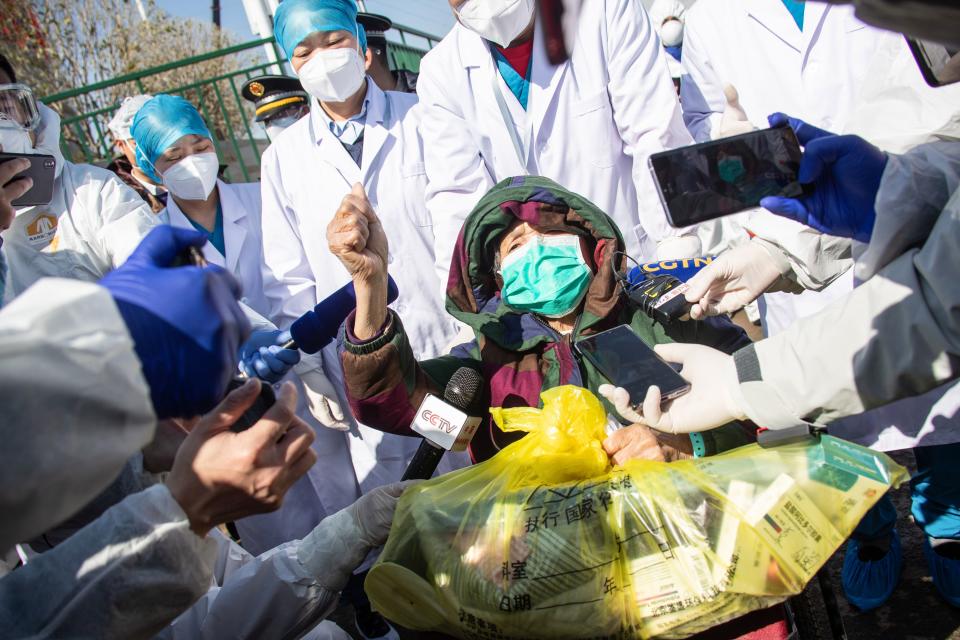Coronavirus Covid-19 'mild' in more than four in five cases

More than four in five cases of the coronavirus Covid-19 are mild, research suggests.
Since the previously unknown strain emerged at a seafood and live animal market in the city Wuhan at the end of last year, it has spread worldwide to at least 27 countries.
Read more: How is the coronavirus Covid-19 diagnosed?
Authorities have confirmed more than 73,300 cases, of which 72,438 are in mainland China and 454 onboard the quarantined Diamond Princess cruise ship, according to John Hopkins University.
From China’s 278 cases on 20 January, incidences rose fairly steadily to 44,300 on 11 February, before spiking to 59,800 just two days later.
Diagnoses appear to be tailing off, rising more slowly to 72,400 on 17 February, with no change the following day.
Who is most at risk of coronavirus Covid-19?
Since Covid-19 came too light, experts have wondered who is most likely to catch the infection.
To learn more, scientists from the Chinese Center for Disease Control and Prevention (CCDC) published information on the 44,672 confirmed cases as of 11 February.
They found more than four in five (80.9%) cases were mild, while 13.8% were severe and 4.7% critical, the BBC reported.
The highest fatality rate was in those aged 80 or over, where 14.8% did not recover from infection.
No fatalities had been reported in children up to nine years old.
In patients up to 39, the death rate was 0.2%.
Read more: How to stay calm amid the coronavirus Covid-19 outbreak
This rose to 0.4% among people in their forties, 1.3% for those in their fifties, 3.6% in their sixties and 8% for those in their seventies.
When it comes to other health issues, heart disease was found to be the biggest risk factor, with these patients having a 10.5% death rate.
This was followed by diabetes (7.3%), chronic respiratory disease (6.3%) and high blood pressure (6%).
The team also highlighted the risk posed to medical staff.
As of 11 February, 3,019 health workers were thought to have been infected, of which 1,716 were confirmed cases and five died.
A hospital director at the epicentre of the outbreak in Wuhan died from Covid-19 on 18 February aged 51.

What is coronavirus Covid-19’s death rate?
Covid-19’s death rate is up for debate.
A report by the CCDC estimates the province Hubei - of which Wuhan is capital - has a fatality rate of 2.9%, compared with the rest of China’s 0.4%.
Overall, it predicts a 2.3% death rate.
Earlier this month, scientists from Imperial College London calculated Hubei’s “case-fatality rate” could range from 1% up to 18%.
They noted the “credible interval” goes from 11% up to 81%.
Among “travellers outside mainland China”, the case-fatality rate was estimated at between 1.2% and 5.6%, with “substantial uncertainty”.
Taking into account both asymptomatic and symptomatic incidences, the Imperial scientists calculated the likely overall case-fatality rate to be around 1%.
Authorities have confirmed 1,873 deaths so far, of which 1,789 were in Hubei.
The vast majority of fatalities have occurred in China, however, one person has died from the infection in France, Japan, the Philippines and Taiwan.
While it may sound bleak, a total of 12,887 people have recovered.
There is no specific “anti-viral” drug that treats the infection.
Patients who develop pneumonia are given “supportive care”, like ventilation, while their immune system works to fight off the virus.
Pneumonia comes about when the air sacs (alveoli) in the lungs become inflamed and filled with pus or fluid.
“Without treatment the end is inevitable,” said the charity Médecins Sans Frontières.
“Deaths occurs because of asphyxiation.”
Read more: When is coronavirus Covid-19 expected to 'peak'?
Pneumonia is generally caused by bacteria that tend to respond to antibiotics.
The CCDC paper notes cases appear to be stabilising overall.
“Isolation of whole cities, broadcast of critical information (e.g. promoting hand washing, mask wearing, and care seeking) with high frequency through multiple channels, and mobilization of a multi-sector rapid response teams is helping to curb the epidemic”, the scientists wrote in the Chinese Journal of Epidemiology.
Holidaymakers returning home, however, may “rebound the epidemic”.
Cases spiked on 13 February when Hubei officials began using a broader criteria to diagnose patients, leading to more being told they have the infection.
The same case definition is not being applied in the rest of China, the BBC reported.

What is the new coronavirus Covid-19?
Covid-19 is one of seven strains of the coronavirus class that are known to infect humans.
Others range from the mild common cold to the severe acute respiratory syndrome (Sars) outbreak that killed 774 people in 2004.
Most of the people who initially became unwell worked at, or visited, the Wuhan market.
The only know method of transmission is face-to-face via infected droplets that have been coughed or sneezed out.
It is unclear whether the virus “floats” in the air or can survive on hard surfaces.
While no one can say for sure where the virus came from, bats seem most likely.
The nocturnal creatures are thought to have been behind Sars and fellow coronavirus Middle Eastern respiratory syndrome (Mers).
Scientists from Peking University in Beijing suggested snakes may have been the “intermediate host” for Covid-19.
A team from South China Agricultural University have since found it could have “jumped” from bats to humans via pangolins.
To prevent infection, the NHS recommends regular hand washing and avoiding those with suspect symptoms.



